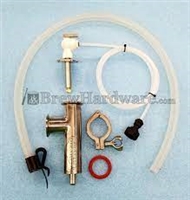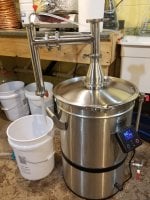Recently I altered something in my brewing system which inherently changes my equipment profile.
I switched my boil kettle from propane to electric and went ahead and purchased a steam condenser so I can brew indoors during winter. So I went ahead and ran a water test in the boil kettle to determine losses and boil off rate for my new equipment profile. I tend to brew 5.5 gallon batches with 5.5 to 5.75 gallons ending up in my fermenter (it used to fluctuate with propane based on weather conditions).
I was expecting a lower boil off rate, but oddly enough, it was the same. I boiled 6.5 gallons of water which seemed like a solid simulation. I ran this for 60 minutes and let this cool down over night rather than use waste water to chill the batch down (I use an immersion chiller). But while it was still hot, I hooked up my pump and simulated a whirlpool for 10 minutes. I shut off the pump and the valves, disconnected the hose and pump to drain that water loss into measuring cups so I could record their volumes. I did not wait for these small volume samples to cool down. The next morning, when the kettle volume was at room temp, I was at about 5.5 gallons indicating that my boil off rate was 1 gallon/hour. Then I drained the kettle completely and recorded the kettle loss volume in water (what was remaining in the kettle).
My mash tun did not change and neither did the rest of my gear. So I took my existing equipment profile and duplicated it, then edited the values within the profile. So all I changed was the loss to trub and chiller volumes.
My previous loss to trub and chiller was 0.30 gallons
My new loss to trub and chiller is 0.67 gallons
I brewed a mid-to-low gravity beer (1.050) with an inverted sugar addition in the 90 minute boil. To produce this beer, I needed 9.17 gallons of water. Beersmith suggested I would have a pre-boil volume of 7.92 gallons. When I finished sparging, my volume was lined up around 8 gallons with the wort being about 165 to 170 degrees. After 90 minutes, I whirlpooled and chilled. When I got down to about 72 degrees, I shut off the chiller and removed it.
I drained the kettle into the fermenter and ended up with 6.6 gallons. Which left me a gallon over where I needed to be. Granted, when I have late sugar additions in the boil, my volume is slightly more than usual. But it's not a gallon or more higher.
My boil off rate was the same as my test---1 gallon per 60 minutes (I account for the 0.10 gallons less boil off due to the sugar addition). I double checked my water volumes. The batch should have been:
5.5 gallons of 1.050 wort
I ended up with:
6.6 gallons of 1.046 wort
Even though I ended up with a lower gravity, my efficiency jumped somewhere, but I wouldn't expect it to be this much with only the boil kettle changing. But I can't account for the additional water. I duplicated the recipe and switched between equipment profiles, adding and removing water as an ingredient, but still get the same number---9.17 gallons to start.
I can't seem to figure out why I have this extra gallon of wort. Did I set up the new equipment profile wrong?
I switched my boil kettle from propane to electric and went ahead and purchased a steam condenser so I can brew indoors during winter. So I went ahead and ran a water test in the boil kettle to determine losses and boil off rate for my new equipment profile. I tend to brew 5.5 gallon batches with 5.5 to 5.75 gallons ending up in my fermenter (it used to fluctuate with propane based on weather conditions).
I was expecting a lower boil off rate, but oddly enough, it was the same. I boiled 6.5 gallons of water which seemed like a solid simulation. I ran this for 60 minutes and let this cool down over night rather than use waste water to chill the batch down (I use an immersion chiller). But while it was still hot, I hooked up my pump and simulated a whirlpool for 10 minutes. I shut off the pump and the valves, disconnected the hose and pump to drain that water loss into measuring cups so I could record their volumes. I did not wait for these small volume samples to cool down. The next morning, when the kettle volume was at room temp, I was at about 5.5 gallons indicating that my boil off rate was 1 gallon/hour. Then I drained the kettle completely and recorded the kettle loss volume in water (what was remaining in the kettle).
My mash tun did not change and neither did the rest of my gear. So I took my existing equipment profile and duplicated it, then edited the values within the profile. So all I changed was the loss to trub and chiller volumes.
My previous loss to trub and chiller was 0.30 gallons
My new loss to trub and chiller is 0.67 gallons
I brewed a mid-to-low gravity beer (1.050) with an inverted sugar addition in the 90 minute boil. To produce this beer, I needed 9.17 gallons of water. Beersmith suggested I would have a pre-boil volume of 7.92 gallons. When I finished sparging, my volume was lined up around 8 gallons with the wort being about 165 to 170 degrees. After 90 minutes, I whirlpooled and chilled. When I got down to about 72 degrees, I shut off the chiller and removed it.
I drained the kettle into the fermenter and ended up with 6.6 gallons. Which left me a gallon over where I needed to be. Granted, when I have late sugar additions in the boil, my volume is slightly more than usual. But it's not a gallon or more higher.
My boil off rate was the same as my test---1 gallon per 60 minutes (I account for the 0.10 gallons less boil off due to the sugar addition). I double checked my water volumes. The batch should have been:
5.5 gallons of 1.050 wort
I ended up with:
6.6 gallons of 1.046 wort
Even though I ended up with a lower gravity, my efficiency jumped somewhere, but I wouldn't expect it to be this much with only the boil kettle changing. But I can't account for the additional water. I duplicated the recipe and switched between equipment profiles, adding and removing water as an ingredient, but still get the same number---9.17 gallons to start.
I can't seem to figure out why I have this extra gallon of wort. Did I set up the new equipment profile wrong?




